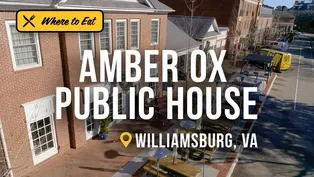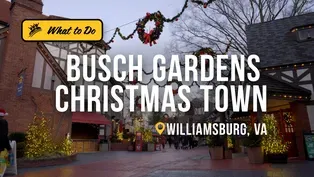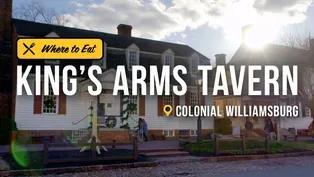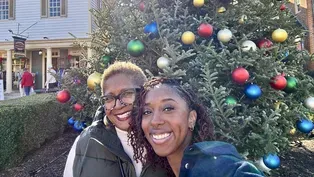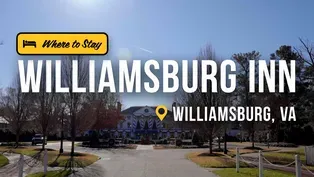Get Out of Town
Explore Black History in Colonial Williamsburg
Clip: Season 2 Episode 3 | 8m 13sVideo has Closed Captions
Laurita and Lauren tour Colonial Williamsburg, the largest U.S. history living museum in the world.
Laurita and Lauren tour Colonial Williamsburg, the largest U.S. history living museum in the world, where they tour the Peyton Randolph house and learn about the 27 enslaved individuals who resided there. The Portees also visit to the Colonial Williamsburg Archeology Office and learn about excavation work at two prominent black history sites, the Bray School and First Baptist Church.
Problems with Closed Captions? Closed Captioning Feedback
Problems with Closed Captions? Closed Captioning Feedback
Get Out of Town is a local public television program presented by WETA
Get Out of Town
Explore Black History in Colonial Williamsburg
Clip: Season 2 Episode 3 | 8m 13sVideo has Closed Captions
Laurita and Lauren tour Colonial Williamsburg, the largest U.S. history living museum in the world, where they tour the Peyton Randolph house and learn about the 27 enslaved individuals who resided there. The Portees also visit to the Colonial Williamsburg Archeology Office and learn about excavation work at two prominent black history sites, the Bray School and First Baptist Church.
Problems with Closed Captions? Closed Captioning Feedback
How to Watch Get Out of Town
Get Out of Town is available to stream on pbs.org and the free PBS App, available on iPhone, Apple TV, Android TV, Android smartphones, Amazon Fire TV, Amazon Fire Tablet, Roku, Samsung Smart TV, and Vizio.
Providing Support for PBS.org
Learn Moreabout PBS online sponsorship♪ LAUREN: We're gonna go drive around to the Governor's Palace, and get to do a little sightseeing with the horses.
Here's our carriage, oop, we're moving.
(horses clopping).
CASH: Colonial Williamsburg is the largest U.S. history living museum in the world.
We have over 300 acres.
We have 89 original buildings that have been standing here in Williamsburg for nearly 250 years.
In 1926, the Reverend Dr. William Archer Rutherfoord Goodwin, and John D. Rockefeller Jr, who was one of the wealthiest men in America, realized the opportunity to restore the historic area of Williamsburg.
Guests from all over the world come to visit to hear the story of our nation's founding, and to learn about the experiences of the persons here.
But, for much of the history of the museum, Colonial Williamsburg, the narrative has been one that tells the story of George Washington, and James Madison, Patrick Henry, and Thomas Jefferson.
Folks who look like me.
But over half of the population of the city of Williamsburg in 1776 is enslaved.
Visiting the Peyton Randolph house today, you would hear the stories of Peyton Randolph, but also at that site, you're going to hear the stories of 27 persons enslaved by Peyton Randolph.
♪ LAURITA: Good morning!
JANICE: Good morning, good morning.
How are you?
LAURITA: Good!
LAUREN: Good, how are you?
JANICE: My name's Janice Canaday, it's a pleasure to meet you.
LAURITA: Hi, I'm Laurita.
LAUREN: And I'm Lauren.
JANICE: Hi, Lauren.
LAUREN: Hi.
JANICE: Welcome to the Peyton Randolph property.
BOTH: Thank you.
LAUREN: So, we don't know too much about Peyton Randolph, could you give us a little bit of a snapshot on him?
JANICE: Peyton Randolph was a very wealthy man, very prominent family that he comes from.
Randolph's a very large family, he's kin to Thomas Jefferson.
He's living here in the capital city, he's a plantation owner, owner of human property, he owns 109 enslaved people, 27 of which stayed in this property.
LAURITA: How many people lived there with him?
JANICE: Himself and his wife.
LAUREN: 27.
LAURITA: Wow, that was a lot of... help for two people.
JANICE: Indeed.
LAUREN: Is it possible for us to take a peek inside of the house?
JANICE: Absolutely, we're gonna have a look back here at what they called the servant's hall.
This is where the folks that, the 27 enslaved on the property, would be living.
LAURITA: So if you worked in the kitchen, you lived in it... JANICE: Then you're living above stairs in the kitchen.
If you're in the laundry, you're above stairs in the laundry.
LAURITA: Okay.
It looks like a lot of pots and pans, so it looks like they cooked for a lot of people.
JANICE: They cooked for whoever comes to this house, everybody wants to come to Peyton Randolph's house.
Folks that go to the governor's table, come to this man's table.
And there would be boys here, girls here, men and women.
(thumping).
You feel that?
BOTH: Yes.
JANICE: That's the sound of the work.
LAUREN: Wow.
JANICE: So they're grinding up corn with this.
BOTH: Wow.
JANICE: So they're milling their own corn so they can eat.
This man can afford to have it milled, but that's what they're gonna do for themselves.
LAUREN: It seems that these people really worked hard.
All of this was built on their backs, and it's really important that this history is being told.
JANICE: I don't want you to think that they just worked all the time, these people found a way to create communities, and have moments of that special joy that most people wouldn't think about.
LAUREN: Good.
JANICE: And I'd like to think that one of those places that they experienced that joy when they had time, would be over at the Witness Tree, the Compton oak tree that we have just outside.
This tree here is an iconic tree.
Just as you see that tree is deeply rooted, so is this community here.
And I am deeply rooted here, because my family has always been here, we go back as far as the Revolutionary War.
We use this tree in the community for Juneteenth celebrations.
So it's important to bring the voices of the community to the table, hear them, and then allow them to participate in the writing of the narrative that's going to represent them.
LAUREN: Yes.
JANICE: So it's a very fulfilling fact.
LAUREN: It is.
LAURITA: Thank you so much, this was wonderful.
We really enjoyed meeting you and hearing about all this great information.
JANICE: Pleasure is all mine, please come back.
LAUREN: I know, this was such a special time for you to be telling us the history that so many people don't know about.
So thank you so much for all that you do here.
JANICE: My pleasure.
LAURITA: Take care, happy holidays.
JANICE: Take care, happy holidays.
♪ LAURITA: You know this is the place where they've found a lot of artifacts from the Black churches, and a Black school.
LAUREN: Oh, nice.
LAURITA: Hi!
JACK: Good morning, come on in!
LAURITA: Good morning.
JACK: Welcome to the lab.
LAURITA: Wow.
JACK: We've been doing archaeology for almost 100 years.
LAUREN: Wow.
LAURITA: 100 years?
JACK: Yeah, 1928 is the first excavation ever done here at Colonial Williamsburg.
LAURITA: Oh, wow.
JACK: The first excavations were done on the Capitol building, Raleigh Tavern, and the Governor's Palace.
And early excavations were really focused on finding buildings, so that we could recreate the colonial town.
But, archeology has evolved over time, and we have focused on also understanding the lives of the people that were here in the 18th, 19th, and now even into the 20th century.
We curate over 60 million artifacts in this collection.
So the materials here in front of us come from the excavations of, uh, the First Baptist church.
Which is one of the oldest Black churches in the country.
LAURITA: Mm-hm, yes.
JACK: Still exists today.
LAURITA: Yes.
JACK: And they have been a part of this project from the very beginning.
LAURITA: I see this money box.
JACK: Yeah, we've found at least 12 of these.
The day after Christmas, they would be filled with coins, and they'd be given out to poor members of the community as charity.
The only way to get into these is to smash 'em open.
LAURITA: That's the fun part.
Ah!
JACK: It's scattered all around behind the, the church.
LAUREN: Oh, wow.
JACK: And so we can even start to see where that action is happening.
LAURITA: Yeah.
JACK: Which is really neat.
LAURITA: Usually, with most Black churches, there are cemeteries associated with the church.
Was there a cemetery on that property?
JACK: Sure enough, we now know there are 62 people buried.
BOTH: Wow.
JACK: We were able to extract DNA from one of the individuals, and it came back as an individual with Sub-Saharan African ancestry.
LAURITA: I'm sure that was so special for the legacy of the family, just to know that that was someone that they descended from.
JACK: Yeah, absolutely.
So, as we were excavating around these bricks, we found one of our favorite artifacts for getting a date, which is a coin.
LAURITA: Oh!
JACK: Because they have a date on it!
LAURITA: Makes sense.
JACK: And that coin had the date 1817.
LAURITA: Nice.
LAUREN: Wow.
JACK: So that confirmed us that that was the first permanent structure for one of the oldest Black churches in the country.
BOTH: Wow.
JACK: Archaeology is the leading edge, usually, of these projects.
And, um, in the case of the Bray School, we discovered all these features and all these artifacts, now there's a much larger focus on the history of the school.
So we're looking for the materials that would've been associated with the kids when they were there learning.
LAUREN: Right.
JACK: And one of the ones that we really like to point out, because we have so many of them... LAURITA: I see 'em.
JACK: The ones at the end... LAURITA: Yes.
LAUREN: Are those clay marbles?
JACK: Clay marbles.
Everyone played marbles historically, but they're most often associated with kids.
LAUREN: Mm-hm.
LAURITA: So Jack, now that you've uncovered some of these items, what's the future for all of this?
JACK: The Bray School will be open to guests in 2024, to tell the stories of the students.
And we're gonna rebuild that first church, so that people can have that worship experience people had in the 19th century.
LAURITA: That's wonderful.
Jack, thank you so much, I mean we actually feel very honored that we were able to see these things before they were open to the public.
So, we can't wait to come back.
LAUREN: Right.
I just want to thank you for showing this history, cause sometimes it does get lost.
So being able to find these artifacts is so important, so thank you for doing this.
JACK: Oh, you're most welcome.
To be able to see Lauren and Laurita engage with these artifacts in the same way that we do, that's the experience we want for everybody to have when they come to Williamsburg.
♪
Amber Ox Public House Offers Unforgettable Farm-to-Table Dining in Williamsburg
Video has Closed Captions
Laurita and Lauren enjoy a delectable meal at Amber Ox Public House in downtown Williamsburg. (3m 10s)
Busch Gardens Williamsburg Christmas Town is Virginia's Biggest Holiday Light Display
Video has Closed Captions
Laurita and Lauren experience the magic of the holiday season at Busch Gardens Williamsburg Christma (2m 34s)
King's Arms Tavern Offers Colonial Cuisine and History in Williamsburg
Video has Closed Captions
Laurita and Lauren visit King's Arms Tavern in Colonial Williamsburg. (4m 2s)
Laurita & Lauren travel to Williamsburg for a weekend of history and holiday cheer. (30s)
The Williamsburg Inn is the Epitome of Luxury and Elegance
Video has Closed Captions
Laurita and Lauren enjoy a stay at the Williamsburg Inn, a five star hotel in Colonial Williamsburg. (2m 52s)
Providing Support for PBS.org
Learn Moreabout PBS online sponsorshipSupport for PBS provided by:
Get Out of Town is a local public television program presented by WETA
